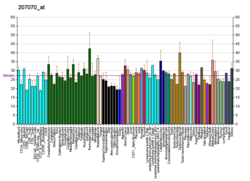Retinal G protein coupled receptor
NM_001012720
NM_001012722
NM_002921
NM_001301692
NM_001301694
NM_021340
NP_001012738
NP_001012740
NP_002912
NP_001288621
NP_001288623
NP_067315
RPE-retinal G protein-coupled receptor also known as RGR-opsin is a protein that in humans is encoded by the RGR gene.
RGR-opsin is a member of the rhodopsin-like receptor subfamily of GPCR. Like other opsins which bind retinaldehyde, it contains a conserved lysine residue in the seventh transmembrane domain. RGR-opsin preferentially binds all-trans-retinal, which is the dominant form in the dark adapted retina,upon light exposure it is isomerized to 11-cis-retinal. Therefore, RGR-opsin presumably acts as a photoisomerase to convert all-trans-retinal to 11-cis-retinal, similar to retinochrome in invertebrates. 11-cis-retinal is isomerized back within rhodopsin and the iodopsins in the rods and cones of the retina. RGR-opsin is exclusively expressed in tissue close to the rods and cones, the retinal pigment epithelium (RPE) and Müller cells. RGR-opsin may be associated with autosomal recessive and autosomal dominant retinitis pigmentosa (arRP and adRP, respectively). RGR-opsin comes in different isoforms produced by alternative splicing.
...
Wikipedia





